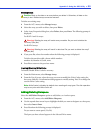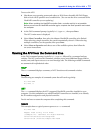
Appendix D: Using the AFU for DOS ● 73
SAVE
The
SAVE
command saves the contents of a HostRAID controller’s flash in a UFI file. The name
of the UFI file is based on the HostRAID controller type and cannot be changed.
Command Syntax
The command syntax for the
SAVE
command is as follows:
AFU SAVE [/C<Controller ID>] [/D <UFI File Path>]
Command Switches
The following switches are available:
● /C <Controller ID> is one or more HostRAID controller IDs representing the set of
controllers on which to perform the specified command. The default is 0, which means
that if the computer has multiple HostRAID controllers, the AFU defaults to controller 0
unless you specify otherwise.
You can specify a single HostRAID controller ID, for example:
/C 0
multiple IDs separated by commas, for example:
/C 0,2
or
ALL
to indicate all HostRAID controllers.
Note:
If you are using multiple HostRAID controllers, you must specify the controller
you want by using the /C switch; otherwise, the AFU displays an error message and
exits. You cannot select ALL HostRAID controllers when specifying SAVE.
● /D <UFI File Path> specifies the path (drive and directory) where the UFI files are located.
If you do not specify the /D switch, the AFU looks for, or creates, UFI files in the default
location.
Note:
You cannot specify the name of a UFI file, only its path. UFI filenames are
predefined, based on the HostRAID controller type.
Examples
In the following example, the AFU saves flash contents from HostRAID controller 0 to a UFI
file in the current default drive and directory:
A:\> AFU SAVE /C 0
In the following example, the AFU saves flash contents from Controller 1 to a UFI file in
C:\UFI_FILES.
A:\> AFU SAVE /C 1 /D C:\UFI_FILES


















